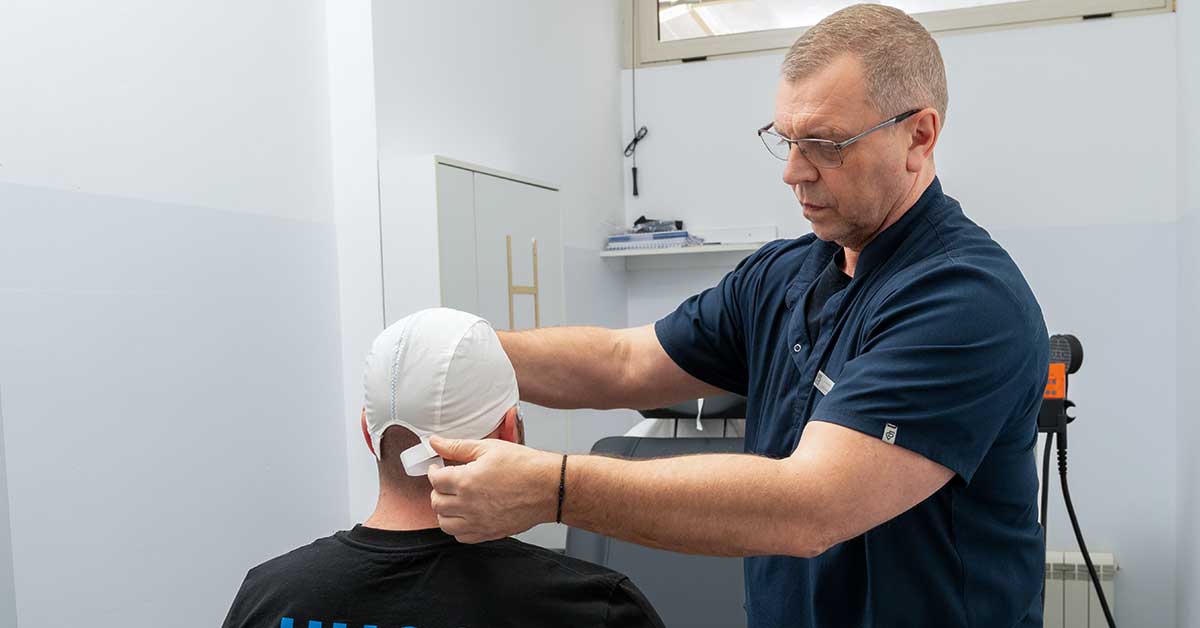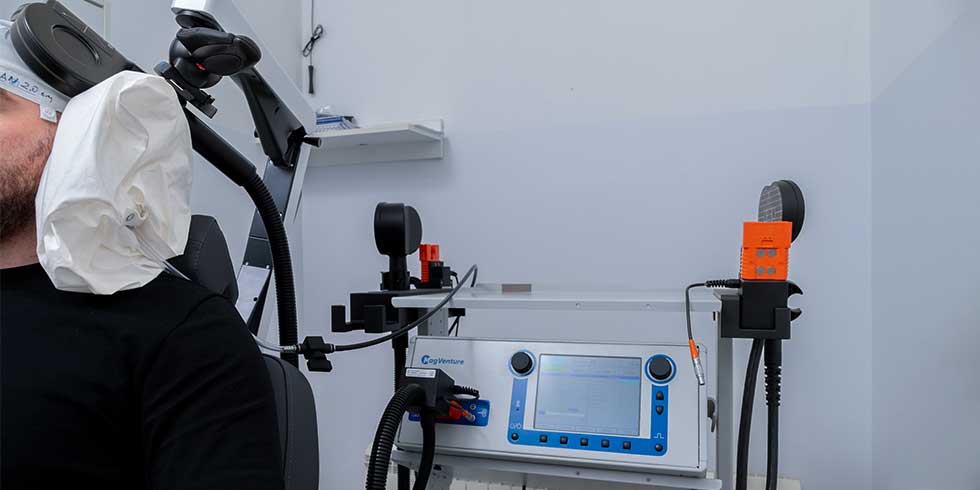Possibility of cost reimbursement through health insurance
A modern approach to tackling addiction, alcoholism, and depression.
Addiction is a complex chronic condition that requires systematic and comprehensive therapy. Although the path to recovery is often long and demanding, modern medicine today offers new possibilities that complement traditional treatment methods. One such innovative method is TMS (Transcranial Magnetic Stimulation) – a non-invasive procedure that uses magnetic fields to stimulate specific areas of the brain associated with self-control, impulses, and craving.
In the context of addiction therapy, TMS is applied as a support in reducing cravings for psychoactive substances and stabilising emotional states, particularly in patients undergoing treatment for addiction to opiates, alcohol, or stimulants. As part of an integrated therapeutic approach, TMS represents an additional resource in building lasting abstinence and improving quality of life.
Transcranial Magnetic Stimulation (TMS) is a non-invasive neurophysiological procedure used to stimulate specific regions of the brain, without the need for medication or surgical intervention. The therapy is carried out using a device that generates short magnetic pulses, directed at targeted areas of the cerebral cortex – most commonly the frontal regions responsible for decision-making, impulse control, and emotional regulation.
Magnetic stimulation induces mild electrical changes in the brain tissue, influencing neural activity in regions that are often disrupted in individuals with addiction. In this way, TMS helps to reduce cravings for psychoactive substances, improves self-control, and contributes to emotional stabilisation.
The procedure is painless, the patient remains awake and fully conscious during the treatment, and the stimulation is delivered through a series of short pulses emitted via a coil placed on the surface of the head. The therapy does not require sedation or recovery time after the session, and the patient can return to daily activities immediately afterwards.
TMS (Transcranial Magnetic Stimulation) is increasingly used in modern medicine as part of the treatment for various forms of addiction. This non-invasive neurostimulation technique aims to modulate brain activity in regions associated with craving mechanisms, impulsivity, and the reward system – key factors in the development and maintenance of addictive behaviour.
Depression is a common comorbidity in individuals with addiction and can significantly affect treatment outcomes. TMS is already used as a standard treatment for patients with treatment-resistant forms of depression, especially when pharmacological approaches fail to produce the desired results. Stimulation of the dorsolateral prefrontal cortex helps regulate emotions and improve mood, which, in patients with a history of addiction, further enhances motivation for recovery and reduces the risk of relapse into addictive behaviour.
In all the above-mentioned cases, TMS is not used as a standalone form of therapy, but rather as a complementary method within a comprehensive, individually tailored treatment plan. It is administered under professional supervision and adapted to the patient’s clinical presentation, type of addiction, and previous course of treatment.
Transcranial Magnetic Stimulation (TMS) was developed as a neurophysiological method for studying and modulating brain activity. Over the past two decades, its therapeutic potential has been confirmed in the treatment of various neuropsychiatric disorders, including depression, obsessive-compulsive disorder, and chronic pain. Based on this experience, TMS is increasingly being researched and applied in the treatment of addiction.
The fundamental assumption is based on the fact that chronic use of psychoactive substances causes structural and functional changes in the brain, particularly in the frontal regions responsible for decision-making, impulse control, and the regulation of emotional responses. These changes lead to a loss of self-control and intense cravings, even when the individual is aware of the consequences of substance use.
TMS enables targeted stimulation of these specific regions—most commonly the dorsolateral prefrontal cortex (DLPFC)—with the goal of normalising their activity. Research has shown that regular TMS treatments can reduce the intensity of cravings and improve cognitive functions impaired by addiction.
Preliminary studies and clinical experience indicate positive effects of TMS in the treatment of alcohol, cocaine, opioid, and nicotine addiction. TMS has shown particular promise in prolonging abstinence, alleviating symptoms of depression that often accompany addiction, and enhancing the effectiveness of psychotherapeutic interventions.
Although this field remains the subject of ongoing research, current findings suggest that TMS is a safe and well-tolerated method with significant therapeutic potential in the treatment of addiction—especially when applied as part of a professional, integrated therapeutic approach.

Limitations and Factors to Consider:

TMS (Transcranial Magnetic Stimulation) is administered at the clinic as part of a structured therapeutic programme, in a specially equipped room and under the continuous supervision of trained medical staff. The therapy is carried out daily or according to an individually tailored schedule, in line with a treatment plan defined by the clinical team.
During a Session
The patient sits or lies comfortably during the treatment. A specialised coil is placed on the scalp, directly above the targeted brain area, and it emits a series of short magnetic pulses. The procedure is painless, although the patient may feel a mild tapping sensation, pressure, or rhythmic pulsing under the coil, as well as hear the characteristic clicking sounds produced by the device.
One TMS session typically lasts between 20 and 30 minutes, and after the session, the patient can immediately return to the other activities scheduled as part of their clinic stay. There is no need for recovery time, rest, or any special preparation.
Treatment Frequency
TMS therapy is most often administered five times a week over the course of several consecutive weeks. The exact number of sessions and duration of treatment are determined on an individual basis—depending on the diagnosis, type of addiction, accompanying symptoms, and response to therapy.
Safety and Monitoring of Effects
Throughout the TMS treatment, the patient remains under continuous professional supervision. All aspects of the condition are monitored—including the intensity of cravings, emotional responses, and any potential side effects. Based on observations, therapy parameters are adjusted if needed to ensure maximum effectiveness while maintaining complete safety.
In practice, TMS is experienced as a clearly structured, technically precise, and physically and psychologically well-tolerated therapeutic procedure. Patients often describe it as a beneficial and stabilising experience in the recovery process.

TMS (Transcranial Magnetic Stimulation) therapy is not a universal method, but for carefully selected patients, it can provide significant support in the addiction recovery process.
The decision to include this therapy is made by the clinical team based on a comprehensive assessment of the patient’s condition, medical history, and previous treatment attempts.
Transcranial Magnetic Stimulation (TMS) is a modern, safe, and effective addition to addiction treatment, particularly in phases where it is essential to reduce the intensity of cravings, improve emotional stability, and support the patient in maintaining abstinence.
At the MedTiM Clinic, TMS therapy is an integral part of an individually guided rehabilitation programme that combines neurobiological, psychotherapeutic, and pharmacological approaches. The treatment is carried out according to clearly defined protocols, in a controlled clinical setting, and under the continuous supervision of a professional team.